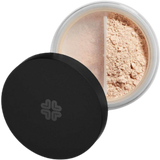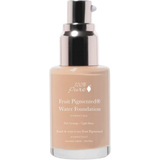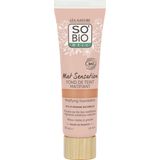Foundation Guide
When looking for a suitable foundation, the desire is for it to even and balance the complexion without leaving a cakey feel on the skin. What exactly is foundation and how does one find a suitable match? Here are some tips and tricks that might ease your selection process.
Foundations and Natural Cosmetics
Foundation can be described as being a cosmetic product that primes the face and optically smooths the complexion. Unlike conventional cosmetics, no silicone or synthetic film formers may be used in a natural foundation. Processed vegetable oils are often used to achieve a pleasant texture and feel on the skin, much like silicone. Mineral foundations are extremely popular in the world of natural cosmetics. They contain the purest ingredients and have a natural feel on the skin.
Textures, Coverage and Finish
Foundations are available in several textures: the classic creamy foundations provide the complexion with care and colour. Liquid foundations have, as the title reads, a fluid composition, that has a lightweight feel on the skin. Compact foundations are convenient for travel due to their practical packaging and have a more solid yet smooth texture. Loose mineral foundations fall under the powdery foundation category and have the widest range of colours to choose from, which is the reason mineral foundations have a more natural look on the skin. BB creams and CC creams have only been on the market for the past 2 or 3 years, and are described as being a kind of tinted day cream, equipped with additional properties such as containing sunscreen filters or other special agents.
Most natural foundations have light to medium coverage, however, in some cases, they also offer full coverage. Powery foundations are buildable, as thin layers can be applied on top of one another. The term "finish" describes whether or not a foundation can be categorized as having a mattifying effect (recommended for combination and oily skin types) or rather a lovely glow (recommended for dry or mature skin types). To emphasize this effect, it is possible to apply a matte, as well as a shimmering powder on top of the foundation.
Finding a Suitable Shade
A foundation should not be too dark or have a cakey appearance on the skin. It is best to test a foundation shade on the jawline.
With a little bit of practice and knowledge about an individual skin tone, a suitable foundation shade can be successfully found in an online shop. Foundations are usually divided into numerous gradients and described and illustrated accordingly. A "fair" shade is described as being suitable for a light skin tone that barely tans, whereas a "light" shade is recommended for light skin tones that tan lightly when exposed to the sun. "Medium" is a slightly brown, central European skin tone and "tan" corresponds to a more southern European skin tone. Darker skin tones are often categorized as a "dark" shade.
Tip: Most women have a lighter skin tone during winter as opposed to summer. Depending on the season, it is practical to find two foundation shades that can be easily blended during the change in season.
To simplify the foundation selection process, the product description contains both gradient/shade and undertone. Undertone is referred to as the colour that underlies the actual, physical skin colour, and are divided into three main groups: cool, neutral and warm. Cooler (pink) undertones match perfectly with silver jewellery, warmer undertones opt for gold jewellery and neutral (olive) undertones can sport both silver and gold jewellery.
Foundation Application Techniques
Professional make-up artists recommend applying a primer as the first step in the foundation application process, as it smooths the skin's appearance. The kinds of tools that are used also influence the appearance of the foundation. Creamy, liquid or compact foundation can be applied using the fingertips, whereby body heat helps the foundation melt into the skin. Brushes usually offer a more evenly distributed application. You might want to opt for a sponge, which aids in a more dense application of the product.
It is advised not to apply a large quantity of foundation to the face at once. Place a small quantity of product on the back of the hand, and using a brush, fingertips or sponge, apply the foundation in thin layers, paying special attention to the areas of the skin that are prone to redness and unevenness.
More powdery foundations are usually applied using a dense brush, such as a kabuki, a small sponge. Since very little product is required, it is recommended to knock off any excess powder before applying the foundation to the face. If the skin appears too cakey, simply spray a hint of blossom water onto the skin.
Tip: For a more natural look apply a thin layer of BB cream on the skin and correct all blemishes or redness using a concealer or a full-coverage foundation.
Foundations for All Skin Types & All Seasons
Dry or mature skin types require a nourishing creamy or compact foundation. BB and CC creams are also great options. The use of rich skin care products is recommended before applying foundation to these skin types. Mineral foundations can also be blended with a day cream. Mineral Foundations or a light liquid foundation are ideal for combination and oily skin types. Sensitive skin also benefits from mineral foundations because these contain the purest ingredients.
Tip: During winter the skin usually requires more nourishment and care. Creamier or compact foundations are best suited during the colder months. More powdery foundations should be used during the warmer summer months since the skin naturally produces more sebum.
Related products
-
 4.6 (2755)
4.6 (2755)Lily Lolo Mineral Foundation SPF 15, Blondie (10 g)
Bestseller- Blondie
- Porcelain
- Candy Cane
- Warm Peach
- Barely Buff
- +15
- Contains natural sunscreen
- Waterproof & long-wearing
- Oil-free & non-comedogenic
£19.25 (£1,925.00 / kg)Delivery by May 07
-
 4.2 (58)
4.2 (58)100% Pure Fruit Pigmented Full Coverage Water Foundation, Warm 4.0 (30 ml)
Bestseller- Warm 4.0
- Cool 1.0
- Cool 2.0
- Warm 1.0
- Warm 2.0
- +6
- For normal to dry skin types
- Hydrates & conditions
- Rich in antioxidants
£44.50 (£1,483.33 / l)Delivery by May 07
-
 1.8 (5)
1.8 (5)LÉA NATURE SO BiO étic Mat Sensation Mattierende Foundation, 30 Sable doré (30 ml)
- 30 Sable doré
- 25 Beige doré
- 20 Beige rosé
- 15 Vanille rosé
- 40 Noisette
- Ideal for oily & combination skin
- Powdery finish
- Optimum nourishment
Magazine Articles:
Discover Ecco Verde:
-
Free delivery in Great Britain
from £49.90 -
Free
returns -
Get at least 1 free sample
per order More than 18.450 products

